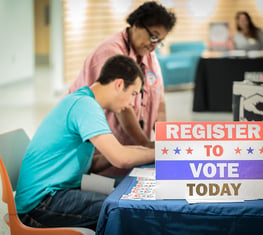This article originally appeared in The New York Times.
WASHINGTON — In a spirited argument on Wednesday, the Supreme Court appeared deeply divided over whether Ohio may kick people off the voting rolls if they skip a few elections and fail to respond to a notice from state officials.
Justice Sonia Sotomayor said Ohio’s approach effectively disenfranchised minority and homeless voters in the state’s major cities and was part of a broader effort to suppress voting.
“All of these impediments result in large numbers of people not voting in certain parts of the state,” she said.
But Justices Anthony M. Kennedy and Stephen G. Breyer expressed concern about maintaining the integrity of the state’s list of eligible voters.
“The reason they’re purging them,” Justice Kennedy said, “is they want to protect the voter rolls from people that have moved.”
Justice Breyer fleshed out the point. “Every year a certain number of people die, and every year a certain number move to California,” he said. “We don’t want them on the voter roll. That used to be a big problem, voting dead people.”
The case concerns Larry Harmon, a software engineer and Navy veteran who lives near Akron, Ohio. He voted in the 2004 and 2008 presidential elections but skipped the next one, saying he was unimpressed by the candidates. He also sat out the midterm elections in 2010 and 2014.
In 2015, Mr. Harmon did want to vote, against a ballot initiative to legalize marijuana. But his name had been stricken from the voting rolls.
Federal laws prohibit states from removing people from voter rolls “by reason of the person’s failure to vote.” But they allow election officials who suspect that a voter has moved to send a confirmation notice.
A central question in the case was whether a failure to vote could be the reason to send out the notice.
Ohio is more aggressive than any other state in purging its voter rolls. After skipping a single federal election cycle, voters are sent a notice. If they fail to respond and do not vote in the next four years, their names are purged from the rolls.
A few other states use similar approaches, but not one of them moves as fast. “Ohio is the only state that commences such a process based on the failure to vote in a single federal election cycle,” said a brief from the League of Women Voters and the Brennan Center for Justice. “Literally every other state uses a different, and more voter-protective, practice.”
At Wednesday’s argument, Eric E. Murphy, Ohio’s state solicitor, said about eight states send out notices based on the failure to vote.
Justice Ruth Bader Ginsburg said there was good reason to think that “Congress didn’t want failure to vote to be a trigger for this procedure.”
But Justice Samuel A. Alito Jr. said the laws appeared to permit Ohio to use its notification process.
“Why isn’t the best interpretation of this that one cannot be removed from the list solely because of failure to vote?” he asked. The failure to respond to the notice, he suggested, was an additional reason.
Paul M. Smith, a lawyer for the challengers, said there were far more reliable methods of figuring out whether people had moved, including consulting records kept by the post office and motor vehicle departments.
On the other hand, Mr. Smith said, “the failure to vote for two years tells you almost nothing about whether or not anybody has moved.”
He said more than half of Ohio voters sit out elections over a two-year period and 70 percent of people who receive notices from the state do not return them.
“The process is vastly overbroad in its design,” Mr. Smith said. “You’re just going to end up with a lot of false positives.”
Mr. Smith added that it is lawful for states to send nonforwardable notices based on the failure to vote, and take action based on the ones returned as undeliverable.
Chief Justice John G. Roberts Jr. seemed surprised by the concession. “So the triggering event can be the failure to vote?” he asked. “I would have thought that’s inconsistent with the rest of your argument.”
But the distinction between a failure to respond to a notice and one returned as undeliverable seemed to appeal to Justice Breyer.
Justices Clarence Thomas and Neil M. Gorsuch asked no questions.
The United States Court of Appeals for the Sixth Circuit, in Cincinnati, ruledin favor of Mr. Harmon in 2016, saying that Ohio had violated the National Voter Registration Act of 1993 by using the failure to vote as a “trigger” for sending the notices.
Without that decision, “the ballots of more than 7,500 eligible Ohioans would have gone uncounted in the November 2016 election,” Mr. Harmon’s lawyers at Demos and the American Civil Liberties Union wrote in a Supreme Court brief.
A Reuters study in 2016 found that at least 144,000 people were removed from the voting rolls in recent years in Ohio’s three largest counties, which are home to Cleveland, Cincinnati and Columbus.
“Voters have been struck from the rolls in Democratic-leaning neighborhoods at roughly twice the rate as in Republican neighborhoods,” the study found. “Neighborhoods that have a high proportion of poor, African-American residents are hit the hardest.”
Twelve states, generally led by Democrats, filed a brief supporting Mr. Harmon. Seventeen states, generally Republican, filed a brief on the other side.
The Justice Department for decades took the position that failing to vote should not lead to disenfranchisement. In the appeals court, the Obama administration filed a brief supporting Mr. Harmon.
After the last presidential election, the department switched sides in the case, Husted v. A. Philip Randolph Institute, No. 16-980.
Questioning Solicitor General Noel J. Francisco, Justice Sotomayor said that it “seems quite unusual that your office would change its position so dramatically,” particularly where the new stance had “a negative impact on certain groups in this society.”
Mr. Francisco responded that further study of the key statute and a concern for states’ rights had prompted the shift.
Late in the argument, Justice Alito said the case must turn on the words of the governing federal laws.
“It’s a very important subject,” he said. “It’s a sensitive subject. As a policy matter, there are strong arguments on both sides.”
“Congress had struck a compromise,” Justice Alito said. “What we have before us is a question of statutory interpretation, not a question of what we think would be the ideal system for achieving the result of removing people who have moved from the voter lists.”




